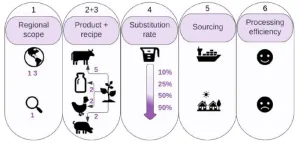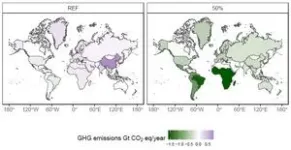(Press-News.org) Replacing 50% of meat and milk products with plant-based alternatives by 2050 can reduce agriculture and land use related greenhouse gas (GHG) emissions by 31% and halt the degradation of forest and natural land, according to new research.
According to the study just published in Nature Communications, additional climate and biodiversity benefits could accrue from reforesting land spared from livestock production when meat and milk products are substituted by plant-based alternatives, more than doubling the climate benefits and halving future declines of ecosystem integrity by 2050. The restored area could contribute up to 25% of the estimated global land restoration needs under Target 2 of the Kunming Montreal Global Biodiversity Framework by 2030.
The study is the first to look at the global food security and environmental impacts of plant-based meat and milk consumption at large scales that considers the complexity of food systems. The research was conducted independently by IIASA in partnership with the Alliance of Bioversity and CIAT, as well as USAID, and solicited input from Impossible Foods – a company that develops plant-based substitutes for meat products – as a potential user of the data to ensure relevance. The company also provided generic recipes for the plant-based meat substitute products used in the analysis. The data are, however, not specific to Impossible Foods and the science team had complete control over decision making.
“Understanding the impacts of dietary shifts expands our options for reducing GHG emissions. Shifting diets could also yield huge improvements for biodiversity,” notes study lead author Marta Kozicka, a researcher in the IIASA Biodiversity and Natural Resources Program.
“Plant-based meats are not just a novel food product, but a critical opportunity for achieving food security and climate goals while also achieving health and biodiversity objectives worldwide. Yet, such transitions are challenging and require a range of technological innovations and policy interventions,” adds study coauthor Eva Wollenberg from Alliance of Bioversity International and CIAT and the Gund Institute, University of Vermont.
The authors developed scenarios of dietary changes based on plant-based recipes for beef, pork, chicken, and milk. The recipes were designed to be nutritionally equivalent to the original animal-derived protein products and realistic for the existing food manufacturing capabilities and globally available production ingredients (Fig 1).
The authors found that a 50% substitution scenario would substantially reduce the mounting impacts of food systems on the natural environment by 2050 compared to the reference scenario (Fig 2). The impacts as compared to 2020 include:
Global agricultural area declines by 12% instead of expanding.
The decline in areas of forest and other natural land is almost completely halted.
Nitrogen inputs to cropland are nearly half of the projections.
Water use declines by 10% instead of increasing.
Without accounting for any carbon sequestration on spared land, GHG emissions could decline by 2.1 Gt CO2eq year-1 (31%) in 2050 (1.6 Gt CO2eq year-1 on average in 2020–2050).
Undernourishment globally declines to 3.6%, as compared to 3.8% in the reference scenario (reducing the number of undernourished people by 31 million).
The full environmental benefit of diet shifts can be achieved if the agricultural land spared from livestock and feed production is restored through biodiversity-minded afforestation. In the 50% scenario, the benefits from reduced land-use emissions could double as compared to a scenario without afforestation – a total reduction of 6.3 Gt CO2eq year-1. At 90% substitution, the reduction of all agriculture and land-use emissions would increase to 11.1 Gt CO2eq year-1 in 2050.
The restoration of forest ecosystems would also improve biodiversity. The 50% scenario would reduce predicted declines in ecosystem integrity by more than half, while the 90% scenario could reverse biodiversity loss between 2030 and 2040.
“While the analyzed dietary shifts serve as a powerful enabler for reaching climate and biodiversity goals, they must be accompanied by targeted production side policies to deliver their full potential. Otherwise, these benefits will be partly lost due to production extensification and resulting GHG and land-use efficiency losses,” explains IIASA Biodiversity and Natural Resources Program Director Petr Havlík, who coordinated the study.
The study points out that impacts across regions could differ due to differences in population size and diets, unequal agricultural productivity, and participation in international trade of agricultural commodities. The main impacts on agricultural input use are in China and on environmental outcomes in Sub-Saharan Africa and South America. These regional differences could also be used to design better interventions.
“A global introduction of all novel alternatives has additional benefits compared to the scenarios with limited product or geographical scope, but regional substitution of specific products may be highly effective, especially if combined with regional strategies and purposeful selection of recipes,” Kozicka explains.
While the results support the increased use of plant-based meat substitutes, the authors recognize that livestock are a valuable source of income and nourishment for smallholders in low- and middle-income countries, and have significant cultural roles, reduce risk, and diversify smallholder income. Simultaneously, climate change threatens the livelihoods of smallholder farmers. Rapid policy and management action to avoid environmental risk and support farmers and other livestock value chain actors for a socially just and sustainable food system transition will therefore be crucial. This is particularly important considering recent setbacks to achieving food security globally.
Reference
Kozicka, M., Havlík, P., Valin, H., Wollenberg, E., Deppermann, A., Leclère, D., Lauri, P., Moses, R., Boere, E., Frank, S., Davis, C., Park, E., Gurwick, N. (2023). Feeding climate and biodiversity goals with novel plant-based meat and milk alternatives. Nature Communications DOI: 10.1038/s41467-023-40899-2
END
Plant-based food alternatives could support a shift to global sustainability
2023-09-12
ELSE PRESS RELEASES FROM THIS DATE:
Study: People who used e-cigarettes before pregnancy were more likely to stop smoking later in pregnancy than those using nicotine replacement therapy
2023-09-12
BUFFALO, N.Y. – The risks of smoking during pregnancy for both maternal and fetal health are well documented, but only about half of pregnant people quit smoking on their own. To learn more about how e-cigarette or nicotine replacement therapy (NRT) influences smoking cessation later in pregnancy, University at Buffalo researchers compared abstinence rates in the two groups. They found that those using e-cigarettes before pregnancy were more likely to abstain from smoking later in pregnancy.
Published in JAMA Network Open on Sept. 12, the research was conducted as an observational study of data gathered from 1,329 pregnant people through the U.S. ...
New rivers in the North? Scientists identify how the dissection of Arctic landscapes is changing with accelerating climate change
2023-09-12
New research co-led by Simon Fraser University and the University of British Columbia shows that amplified global warming in the Canadian High Arctic drove a profound shift in the structure of a river network carved into a permafrost landscape in only 60 years. Documenting a powerful interplay among climate change, the freeze-thaw dynamics of polygonal ground and the delivery of surface water by floods as well as snow and ice melting, the team developed a new view of the physical controls governing the speed and pattern of river channel development in these fragile landscapes.
“One ...
Unveiling dynamics of human macrophage specification during prenatal development
2023-09-12
Researchers led by Prof. LI Hanjie from the Shenzhen Institute of Advanced Technology (SIAT) of the Chinese Academy of Sciences have unveiled the dynamics of human macrophage specification across 19 different tissues from early embryonic stages.
The study was published in Cell on Sept. 12.
Macrophages, i.e., pivotal immune cells, have long been enigmatic in terms of their diversity and roles during human development. Based on findings in rodents, the scientific community has gained some insights into the diversity, developmental origins, and tissue-specific formation of macrophage subtypes. However, it was not clear whether these findings are conserved in humans.
In this ...
Researchers discover genes behind antibiotic resistance in deadly superbug infections
2023-09-12
Researchers discover genes behind antibiotic resistance in deadly superbug infections
Australian researchers have uncovered new genetic insights into Staphylococcus aureus, revealing what makes the bacterium so dangerous when it enters the blood.
While common, Staphylococcus aureus infections – known as Golden staph – can be life-threatening if the bacteria enter the bloodstream, causing sepsis. Golden staph is notorious for its ability to become resistant to antibiotics, making it hard to treat, which can lead to adverse health outcomes for patients infected with a drug-resistant ...
Race and ethnicity and nonpharmacologic care for chronic low back pain
2023-09-12
About The Study: In this study of Medicare beneficiaries with comorbid chronic low back pain and opioid use disorder (OUD), receipt of physical therapy and chiropractic care was low overall and lower across most racial and ethnic minority groups compared with non-Hispanic white persons. The findings underscore the need to address inequities in guideline-concordant pain management, particularly among Black or African American and Hispanic persons with OUD.
Authors: Patience Moyo, Ph.D., of the Brown University School of Public Health in ...
Study of bacteria in day care settings reveals links with children’s lung health
2023-09-12
Milan, Italy: Particular combinations of bacteria found in dust at day care facilities have been linked to wheezing in young children in a study presented at the European Respiratory Society International Congress in Milan, Italy [1]. Wheezing in young children is often an early sign of asthma.
Children may spend many hours in day care each week and research suggests that conditions in day care settings can have an impact on respiratory health in early childhood. The new research offers some clues ...
Infants less than one year old most impacted by famine of the Dutch Hunger Winter with highest mortality rate
2023-09-12
During the Dutch Hunger Winter Famine, infants experienced the highest absolute and relative mortality of all children under 14 years of age. These are findings from a new study at Columbia University Mailman School of Public Health, Wageningen University & Research and the Netherlands Interdisciplinary Demographic Institute in the Hague. the Netherlands. In the famine cities, infant mortality increased to one percent or 922 deaths per 10,000 compared to 109 deaths per 10,000 children between the ages of one and four, and 27 deaths per 10,000 deaths at ages 5 to 14. ...
Pneumococcal vaccines linked with fewer severe infections among children with sickle cell disease
2023-09-12
New research published today in Blood Advances reveals that since the introduction of pneumococcal conjugate vaccines, PCV7 and PCV13, invasive pneumococcal infection (IPD) rates among children living with sickle cell disease (SCD) have declined significantly. The study explores the efficacy of existing and emerging vaccines to protect children living with SCD from life-threatening infections.
SCD is the most common inherited red blood cell disorder in the United States, affecting an estimated 100,000 people. ...
Groundbreaking research reveals the role of TonEBP in lupus and lupus nephritis, opening new avenues for treatment
2023-09-12
A groundbreaking discovery has been made by Professor Hyug Moo Kwon and his research team in the Department of Biological Sciences at UNIST, in collaboration with Professor Jaeseok Yang from Yonsei University. Their study sheds new light on the protein called ‘TonEBP,’ revealing its significant role in the development of lupus and lupus nephritis. This breakthrough not only enhances our understanding of these conditions, but also opens up potential avenues for future treatment options.
Lupus is an autoimmune disorder characterized by autoreactive B cells and dysregulation of various immune cells, including myeloid cells. Lupus nephritis (LN), which ...
Effectiveness of COVID-19 vaccination for babies and young children confirmed in multi-state study
2023-09-12
COVID-19 mRNA vaccination protects babies and young children against COVID-19-associated emergency department/urgent care visits, according to a multistate study from the Centers for Disease Control and Prevention’s VISION Network. The study found that children, age five and younger, who received the original COVID-19 vaccine and the updated vaccine were protected against the need for medical care for COVID in an emergency department or urgent care facility.
Emergency department/urgent care visits are considered indicators of moderate disease. The small number of hospitalizations for children ages six months to five years old limited the assessment of vaccine ...






